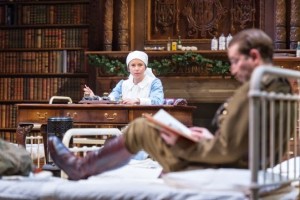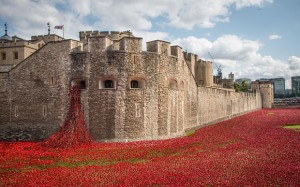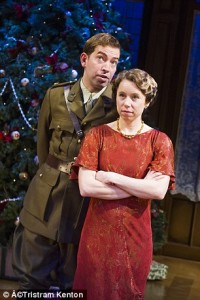This week the marking of the centenary of the outbreak of World War 1 has reached its climax with Remembrance Sunday and Armistice Day. The installation of the sea of ceramic poppies at the Tower of London has shown how emotionally engaging art can be, but Prince Harry’s visit to Kandahar airfield in Afghanistan, where he has been on active service himself, was also memorable. Representing the Queen, he laid a wreath with a personal handwritten note: “There is no greater love than to lay down one’s life for one’s friends. They will never be forgotten. Harry.” The quote is adapted from a passage in St John’s Gospel which Harry also read out at the memorial service.
The Royal Shakespeare Company’s act of remembrance for the beginning of WW1 is the scheduling of three linked plays. The play that will complete the trilogy, The Christmas Truce, has not yet opened, but the other two have been performed over the last few weeks. The Christmas Truce will deal with the famous football match on Christmas Day 1914 that took place in No Man’s Land between soldiers whose countries were at war. How do the productions of two of Shakespeare’s comedies, Love’s Labour’s Lost and Much Ado About Nothing (Love’s Labour’s Won), stand up at this sober time?
The Director of both, Christopher Luscombe, stresses the theme of friendship. Love’s Labour’s Lost begins with four friends vowing to study together although the idea of banning pleasure in the pursuit of learning is almost immediately undercut by “necessity”. Luscombe comments: “The idyllic, pastoral world of Love’s Labour’s Lost, with tragedy waiting in the wings, seems particularly well suited to the fragile beauty of the last Edwardian summer.”
Male friendship, which would be destroyed by the conventional ending of a comedy with marriage, is preserved to the end of the play and beyond. The four young men are all told to live an “austere and insociable life” with “frost and fasts, hard lodging and thin weeds”, that in this production translates into enlisting in the army for World War 1.
Much Ado About Nothing begins with the line-up of soldiers in uniform just as Love’s Labour’s Lost had ended. The boys of the first play, who had written love-poems and dressed up as outrageous Russians, have experienced the camaraderie as well as the horrors of war, and now return to civilian life. Berowne has morphed into Benedick, the King of Navarre into an injured and embittered Don John, and the most innocent of them, the teddy-bear loving Dumain into Claudio. Michelle Terry’s Rosaline becomes, of course, Beatrice, and Flora Spencer-Longhurst is Katherine in the first play and Hero in the second.

Michelle Terry as Beatrice and Edward Bennett as Benedick. in the opening scene of Much Ado. Photo by Manuel Harlan.
Many productions find a setting in which Claudio’s behaviour can be explained, if not excused: India under the Raj in 1976, Cuba in 2006. Al Senter writes in his programme note that these are “societies where much of life is organised around codes of honour and where an innocent young girl’s reputation can be blackened by an illusion”. In this production, set in a post-WW1 country house, the explanation for the appalling behaviour of these young men is that they are physically or mentally scarred by their wartime experiences. Luscombe suggests “ Much Ado About Nothing (or Love’s Labour’s Won) takes place in the aftermath of war, and the erratic behaviour of many of the characters chimes neatly with the fractured society that emerged after the Armistice of 1918.”
Both plays offer many opportunities for music, and Nigel Hess has produced a wonderful score for the plays. It sets both the early twentieth-century scene and the mood of the plays, and is some of the most effective I can remember. The exuberant silliness of the Nine Worthies in Love’s Labour’s Lost is evoked with a “nod in the direction of Gilbert and Sullivan”. After the 1920s dance music for the ball and the Christmas-time gulling of Beatrice and Benedick, the mood in the second half of Much Ado About Nothing changes. Nigel Hess’s setting of the carol “In the Bleak Midwinter”, beautifully sung by the whole cast, signals the developing seriousness of the plot against Hero. It’s a perfect choice, linking the harshness of wartime when “earth stood hard as iron” with the promise of new life if one gives one’s heart. The recurring song and the finale to the play is a version of Marlowe’s “Come live with me and be my love”, joyful without being flashy, with a catchy melody I’ve been humming for the past week.
Friendship, forgiveness, reconciliation, healing, the restoration of harmony and hope for a peaceful future. These productions are a fitting tribute to those who gave their lives a hundred years ago, and yet another reminder of Shakespeare’s understanding of the human heart.
There are several pages about the productions on the RSC’s website, including two written by Christopher Luscombe, their director. If you want to hear the music the RSC have released it on CDs or for download, including recordings of key speeches and of music from the archives.



